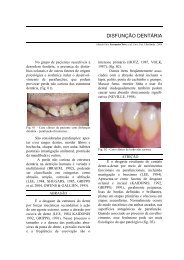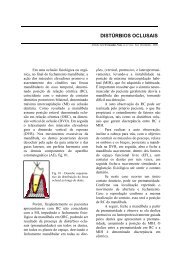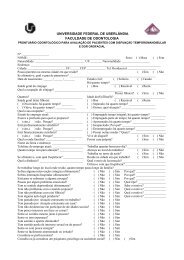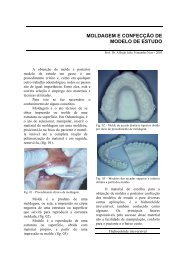Influence of cavity preparation design on fracture resistance of ...
Influence of cavity preparation design on fracture resistance of ...
Influence of cavity preparation design on fracture resistance of ...
You also want an ePaper? Increase the reach of your titles
YUMPU automatically turns print PDFs into web optimized ePapers that Google loves.
THE JOURNAL OF PROSTHETIC DENTISTRY SOARES ET AL<br />
advocated for posterior ceramic restorati<strong>on</strong>s have been<br />
based <strong>on</strong> traditi<strong>on</strong>al cast metal restorati<strong>on</strong> <str<strong>on</strong>g>design</str<strong>on</strong>g>s, but<br />
with more occlusal tooth reducti<strong>on</strong> and a slightly increased<br />
taper. 3 These <str<strong>on</strong>g>preparati<strong>on</strong></str<strong>on</strong>g>s can involve the removal<br />
<str<strong>on</strong>g>of</str<strong>on</strong>g> c<strong>on</strong>siderable tooth structure, 13 and as more<br />
structure is removed, a tooth will have less <strong>resistance</strong><br />
to <strong>fracture</strong>. 14 However, in <str<strong>on</strong>g>preparati<strong>on</strong></str<strong>on</strong>g>s for posterior ceramic<br />
restorati<strong>on</strong>s, some authors have dem<strong>on</strong>strated<br />
that occlusal reducti<strong>on</strong> results in a reduced chance <str<strong>on</strong>g>of</str<strong>on</strong>g> restorati<strong>on</strong><br />
failure, likely increasing l<strong>on</strong>gevity <str<strong>on</strong>g>of</str<strong>on</strong>g> the restorati<strong>on</strong>.<br />
4,6,15 Fracture <strong>resistance</strong> tests have been used to<br />
determine the forces that may induce <strong>fracture</strong> <str<strong>on</strong>g>of</str<strong>on</strong>g> such<br />
restorati<strong>on</strong>s, and thus enable a <str<strong>on</strong>g>preparati<strong>on</strong></str<strong>on</strong>g> <str<strong>on</strong>g>design</str<strong>on</strong>g> to<br />
be suggested for providing greatest <strong>resistance</strong> to <strong>fracture</strong>.<br />
10,16-26<br />
Dental ceramics are c<strong>on</strong>sidered to be esthetic restorative<br />
materials with desirable characteristics, such as<br />
translucence, fluorescence, and chemical stability. 17,27<br />
They are also biocompatible, have high compressive<br />
strength, and their thermal expansi<strong>on</strong> coefficient is similar<br />
to that <str<strong>on</strong>g>of</str<strong>on</strong>g> the tooth structure. 27 In spite <str<strong>on</strong>g>of</str<strong>on</strong>g> their<br />
many advantages, ceramics are fragile under tensile<br />
strain, making them susceptible to <strong>fracture</strong> during the<br />
luting procedure and under occlusal force. 28-31 This<br />
dichotomy raises an important questi<strong>on</strong> as to which is<br />
the best <str<strong>on</strong>g>cavity</str<strong>on</strong>g> <str<strong>on</strong>g>preparati<strong>on</strong></str<strong>on</strong>g> <str<strong>on</strong>g>design</str<strong>on</strong>g> for posterior teeth<br />
restored with ceramic restorati<strong>on</strong>s.<br />
Therefore, the aim <str<strong>on</strong>g>of</str<strong>on</strong>g> this study was to assess the<br />
in vitro <strong>resistance</strong> to <strong>fracture</strong> <str<strong>on</strong>g>of</str<strong>on</strong>g> Leucite-reinforced<br />
ceramic-restored posterior teeth, and to analyze the<br />
modes <str<strong>on</strong>g>of</str<strong>on</strong>g> <strong>fracture</strong> with various <str<strong>on</strong>g>preparati<strong>on</strong></str<strong>on</strong>g> <str<strong>on</strong>g>design</str<strong>on</strong>g>s.<br />
The null hypothesis was that different <str<strong>on</strong>g>preparati<strong>on</strong></str<strong>on</strong>g><br />
<str<strong>on</strong>g>design</str<strong>on</strong>g>s have no effect <strong>on</strong> the <strong>fracture</strong> <strong>resistance</strong> <str<strong>on</strong>g>of</str<strong>on</strong>g> teeth<br />
restored with Leucite-reinforced ceramics.<br />
MATERIAL AND METHODS<br />
Fig. 1. Cavity <str<strong>on</strong>g>preparati<strong>on</strong></str<strong>on</strong>g> <str<strong>on</strong>g>design</str<strong>on</strong>g>s <str<strong>on</strong>g>of</str<strong>on</strong>g> different experimental groups.<br />
Ninety freshly extracted, sound, caries-free human<br />
mandibular molars <str<strong>on</strong>g>of</str<strong>on</strong>g> similar size and shape were<br />
selected by measuring the buccolingual and mesiodistal<br />
widths in millimeters, allowing a maximum deviati<strong>on</strong> <str<strong>on</strong>g>of</str<strong>on</strong>g><br />
10% from the determined mean. Teeth were stored in<br />
0.2% thymol soluti<strong>on</strong>. Calculus and s<str<strong>on</strong>g>of</str<strong>on</strong>g>t-tissue deposits<br />
were removed with a hand scaler. The teeth were cleaned<br />
using a rubber cup and fine pumice water slurry and then<br />
stored in 0.9% saline soluti<strong>on</strong> at 4°C until completi<strong>on</strong> <str<strong>on</strong>g>of</str<strong>on</strong>g><br />
the experiment. The roots were covered with a 0.3-mm<br />
layer <str<strong>on</strong>g>of</str<strong>on</strong>g> a polyether impressi<strong>on</strong> material (Impregum; 3M<br />
ESPE, St Paul, Minn) to simulate the period<strong>on</strong>tal ligament,<br />
and embedded in a polystyrene resin (Cristal,<br />
Piracicaba, Sao Paulo, Brazil) up to 2 mm below<br />
the cementoenamel juncti<strong>on</strong> to simulate the alveolar<br />
b<strong>on</strong>e. 17,24 The teeth were divided into 9 groups<br />
(n=10) as follows: IT, intact teeth (c<strong>on</strong>trol group);<br />
CsI, c<strong>on</strong>servative inlay; ExI, extensive inlay; CsO/mb,<br />
<strong>on</strong>lay with c<strong>on</strong>servative isthmus covering the mesiobuccal<br />
cusp; ExO/mb, <strong>on</strong>lay with extensive isthmus<br />
covering the mesio-buccal cusp; CsO/b, <strong>on</strong>lay with<br />
c<strong>on</strong>servative isthmus covering all buccal cusps; ExO/<br />
b, <strong>on</strong>lay with extensive isthmus covering all buccal<br />
cusps; CsO/t, <strong>on</strong>lay with c<strong>on</strong>servative isthmus covering<br />
all cusps; ExO/t, <strong>on</strong>lay with extensive isthmus covering<br />
all cusps (Fig. 1).<br />
Using a 6-degree taper diam<strong>on</strong>d rotary cutting<br />
instrument (3131; KG Sorensen, Barueri, Sao Paulo,<br />
Brazil), 8 different <str<strong>on</strong>g>preparati<strong>on</strong></str<strong>on</strong>g>s, with internal rounded<br />
angles, were defined. A <str<strong>on</strong>g>preparati<strong>on</strong></str<strong>on</strong>g> machine (Federal<br />
University <str<strong>on</strong>g>of</str<strong>on</strong>g> Uberlandia, Uberlandia, Minas Gerais,<br />
Brazil) was used to standardize <str<strong>on</strong>g>preparati<strong>on</strong></str<strong>on</strong>g> dimensi<strong>on</strong>s<br />
(Fig. 2). 17 This device c<strong>on</strong>sists <str<strong>on</strong>g>of</str<strong>on</strong>g> a high-speed handpiece<br />
(KaVodo Brasil Ltd, Joinville, SC, Brazil) coupled to a<br />
mobile base. The mobile base moves vertically and horiz<strong>on</strong>tally<br />
with the aid <str<strong>on</strong>g>of</str<strong>on</strong>g> 3 micrometers (Mitutoyo,<br />
Tokyo, Japan) with a 0.1-mm level <str<strong>on</strong>g>of</str<strong>on</strong>g> accuracy. The isthmus<br />
floor <str<strong>on</strong>g>of</str<strong>on</strong>g> the mesio-occluso-distal (MOD) cavities<br />
was prepared following principles for ceramic and indirect<br />
composite resin <str<strong>on</strong>g>preparati<strong>on</strong></str<strong>on</strong>g>s. 32 The pulpal floor<br />
was prepared to a depth <str<strong>on</strong>g>of</str<strong>on</strong>g> 2.5 mm from the occlusal<br />
422 VOLUME 95 NUMBER 6









